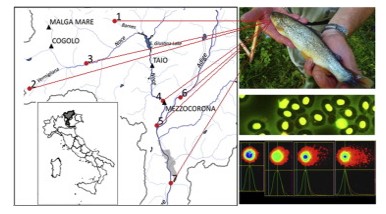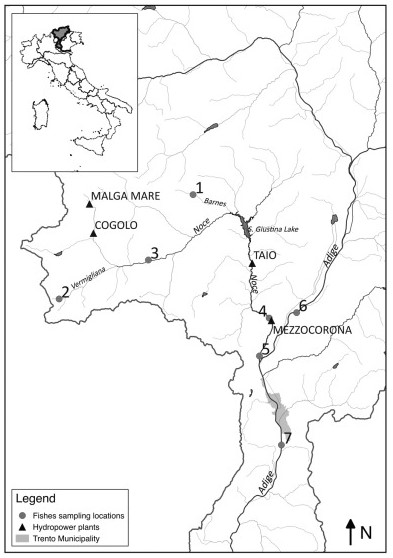Genotoxicological survey of the Adige river basin
- Details
- Created: Thursday, 25 August 2016 10:28
 Scientists working in collaboration from the University of Belgrade, University of Kragujevac, University of Trento, and the Catalan Institute for Water Research, have conducted a comprehensive genotoxicological survey was performed at seven sites in the Adige river basin.
Scientists working in collaboration from the University of Belgrade, University of Kragujevac, University of Trento, and the Catalan Institute for Water Research, have conducted a comprehensive genotoxicological survey was performed at seven sites in the Adige river basin.
The Adige is the second longest river in Italy with a length of 410 km and a total contributing drainage area of about 12,000 km2. The study was carried out at seven sites located along the Adige main course and one the most significant tributaries, the Noce creek, both presenting different levels of pollution pressure.
To give an insight into the nature of the genotoxic activity we employed the battery of prokaryotic and eukaryotic assays. Mutagenicity in water samples was evaluated (please refer to the original publication for the technique). The level of DNA damage as a biomarker of exposure (comet assay) and biomarker of effect (micronucleus assay) and the level of oxidative stress as well (Fpg - modified comet assay) were studied in blood cells of Salmo cenerinus Nardo, 1847 and Salmo marmoratus Cuvier, 1829.
 The comet procedure was performed under yellow light. Briefly, microscope slides were pre-coated with 1% normal melting point (NMP) agarose and air dried for 24 h. The second, supportive layer was formed of 80 μL of 1% NMP agarose. The final layer was formed of 30 μL of cells suspension (prepared as described earlier) gently mixed with 70 μL of 1% low melting point agarose (37 °C). The slides were held in freshly made cold (4 °C) lysis buffer (2.5 M NaCl, 100 mM EDTA, 10 mM Tris, 10% DMSO, 1.5% Triton X-100, pH 10) for 2 h. Denaturation was performed in cold (4 °C) alkaline electrophoresis buffer (300 mM NaOH, 1 mM EDTA, pH 13) for 20 min followed by electrophoresis with a voltage gradient 0.75 V/cm and amperage 300 mA for 20 min at (4 °C). Afterwards, neutralization was carried out in freshly made cold (4 °C) neutralizing buffer (0.4 M Tris, pH 7.5) for 15 min. Slides were preserved by fixation in cold methanol at 4 °C for 15 min. Staining was performed with 20 μL per slide of acridine orange (2 μg/mL) and examination with a fluorescence microscope (Leica, DMLS, Austria, under magnification 400 ×, excitation filter 510–560 nm, barrier filter 590 nm). Microscopic images of comets were scored using Comet Assay IV Computer Software (Perceptive Instruments, UK). Tail intensity (TI % - percentage of DNA in the tail of the comet) was chosen as a measure of DNA damage. For each sample 100 nucleoids were scored. As the possible indication of apoptosis, excessively damaged nuclei or so called hedgehogs (HH) were counted for each slide using a hedgehog tool available in the Comet Assay IV Software.
The comet procedure was performed under yellow light. Briefly, microscope slides were pre-coated with 1% normal melting point (NMP) agarose and air dried for 24 h. The second, supportive layer was formed of 80 μL of 1% NMP agarose. The final layer was formed of 30 μL of cells suspension (prepared as described earlier) gently mixed with 70 μL of 1% low melting point agarose (37 °C). The slides were held in freshly made cold (4 °C) lysis buffer (2.5 M NaCl, 100 mM EDTA, 10 mM Tris, 10% DMSO, 1.5% Triton X-100, pH 10) for 2 h. Denaturation was performed in cold (4 °C) alkaline electrophoresis buffer (300 mM NaOH, 1 mM EDTA, pH 13) for 20 min followed by electrophoresis with a voltage gradient 0.75 V/cm and amperage 300 mA for 20 min at (4 °C). Afterwards, neutralization was carried out in freshly made cold (4 °C) neutralizing buffer (0.4 M Tris, pH 7.5) for 15 min. Slides were preserved by fixation in cold methanol at 4 °C for 15 min. Staining was performed with 20 μL per slide of acridine orange (2 μg/mL) and examination with a fluorescence microscope (Leica, DMLS, Austria, under magnification 400 ×, excitation filter 510–560 nm, barrier filter 590 nm). Microscopic images of comets were scored using Comet Assay IV Computer Software (Perceptive Instruments, UK). Tail intensity (TI % - percentage of DNA in the tail of the comet) was chosen as a measure of DNA damage. For each sample 100 nucleoids were scored. As the possible indication of apoptosis, excessively damaged nuclei or so called hedgehogs (HH) were counted for each slide using a hedgehog tool available in the Comet Assay IV Software.
Within the applied bioassays, the scientists found that the comet assay showed the highest potential for discriminating the sampling sites which are under lesser extent of pressure (sampling sites 1-Barnes at Bresimo and 4-Noce downstream S. Giustina) from the sites under high pressure (sampling sites 5-Noce at Mezzolombardo and 6/7-Adige upstream and downstream municipality of Trento).
The researchers also reported significant correlation between the standard and Fpg-modified comet assay indicated that oxidative stress could be a major contributor to observed DNA damage in collected specimens.
This study represents the first complex survey of the genotoxic potential in the Adige river basin. The data presented in this publication represent a “snapshot” of the current status of the river with an approach which enables detection of the effects of genotoxic pollution on different levels.
For more information, please refer to the original publication:
Evaluation of genotoxic potential throughout the upper and middle stretches of Adige river basin
Margareta Kračun-Kolarevića, Stoimir Kolarevićb, Jovana Jovanovićb, Vanja Markovića, Marija Ilića, Predrag Simonovićb, Vladica Simićc, Zoran Gačićd, Elena Diamantinie, Elisa Stellae, Mira Petrovićf, Bruno Majonee, Alberto Belline, Momir Paunovića, Branka Vuković-Gačićb
Science of The Total Environment, Available online 21 July 2016.
